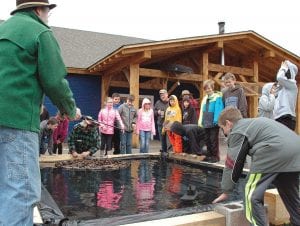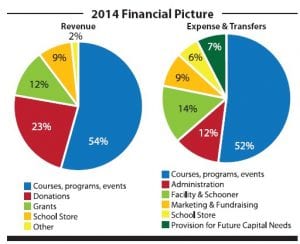Students come from all over the Midwest, the country and all around the world to participate in classes and activities at North House Folk School. The folk school is also the scene of several interesting classes for local students, such as Paddle to the Sea and Building Toboggans/Winter Survival, or as pictured here, Logging History.

Situated on the harbor of Lake Superior in Grand Marais, the tranquil setting for North House Folk School couldn’t be more beautiful or better suited for the vision of the school. Following another record-setting year, North House Folk School Director Greg Wright sat down with the Cook County News-Herald and answered some questions about the folk school.
Students in every season
Asked if North House has seen a growth in attendance or programs, Wright gave an emphatic yes. “Amazingly, we have grown every year since we started back in 1997, the only exception being 2009 during the recession,” said Wright.
Wright said the first year North House offered 23 classes. “In 2014, we broke the 300-plus students per month threshold for the first time,” said Wright.
He added, “In the past three years it has become very apparent that we are now truly a year round school. Indeed, we welcomed as many students to campus in February 2014 as we did in August, which means we are bringing the story of craft alive in every season.”
Students from near and far
Those students come from all over the world, said Wright. Most of the students are from the Midwest, but last year North House welcomed students from 35 different states and five countries
North House also engages county residents. “For instance, there’s nothing better than welcoming local third-, fourth- and fifth-graders to campus every year for the Paddle to the Sea, Logging History, and Toboggan Building/Winter Survival workshops. School students are a partnership we are tremendously proud of.”
North House initiated a new community program this year, called “Making it Through Winter.”
Wright said, “We hope community members will share their thoughts about this program as well as the other events/ programs we host throughout the year.”
With increased enrollment comes increased need for staff. Wright said when he was hired as executive director in 2001, he was the only full-time staff person. Today, North House has eight full-time staffers, three part-time staff members and four interns.
Recent transitions include adding a new fulltime development manager position in 2013 and increasing the volunteer coordinator from parttime to full-time starting in 2015.
The North House budget for payroll and benefits for those 15 people is $363,000.
North House staffers receive vacation pay and health benefits. An added bonus is an allowance to take four class days per year with pay.
“Over the years, we have been fortunate to have staff who both love working with people and are truly invested in North House’s mission. Their pride and dedication to their work has made North House what it is today,” he said.
The cost of the waterfront campus
There is no doubt the scenic location of the folk school is part of its success. The News-Herald asked what North House pays for its use of the waterfront space.
Wright explained that the amount of rent North House pays is based on a formula that the City of Grand Marais defined in the original lease agreement. Wright said the formula increases the rent 2 percent every year. In every fifth year, the base rate is recalculated based on a formal appraisal. In 2014, North House paid a total of $4,027 for its lease.
Wright noted that the formula is based on the assumption that North House’s long-term success is good for Grand Marais and that continued improvements to the campus should be encouraged.
North House’s lease is for 25 years, of which 14 years remain. The lease also defines a number of performance criteria for North House, in areas such as enrollment, campus management and financial strength. If North House meets or exceeds these performance criteria by 2029 when the lease culminates, North House has the option to renew the lease for another 25 years.
Wright stressed that all the improvements made on the city-owned property automatically become city property.
In 2007, North House launched its Raise the Roof campaign, a multi-year initiative to improve the campus by adding buildings and improving classrooms.
“Today, it’s hard to imagine North House without these additions,” said Wright, listing the milling shop, the blacksmith shop, an intern loft for housing, a teaching kitchen in the Fish House, as well as the transformation of the outdoor student commons with improved parking, the big wood-fired oven, timbered entries, and more.
“Thanks to many willing partners, we raised and carefully invested over $850, 000,” said Wright.
Return on investment?
The folk school’s firstyear budget is unknown, but by its third year in 1999, the budget had reached $140,000. In 2001 the budget was $301,000 and in 2014 it was $1,157,911.
Wright said, “Our revenues were $29,659 over our expenses last year.”
Where does North House get its funding? Wright said over 50 percent of revenue comes from classes. He said another 25 percent comes from giving—from in-kind donations, business partners, and $250,000 in donated support. The school store and the sailing vessel Hjordis bring in another 10 percent of the school’s revenue.
North House also gets two key operating grants, one from the Lloyd K. Johnson Foundation that funds development management and one from the Fehner Foundation. “The emergence of the new Anderson Charitable Trust is also an important new fiscal partnership for North House,” said Wright.
Wright said when North House celebrated its 10th anniversary in 2007, an economic impact study was completed. At that time the estimated direct and indirect economic impact on the local economy was $6 million.
Wright explained, “For each $1 a student spent on tuition there was a corresponding $12 of local economic activity, from lodging to meals, gas to supplies, staff compensation to local services.”
Because North House has grown, Wright said he believes the school’s economic impact has grown as well.
“What is tremendously satisfying is the growing sense of collaboration we share with community businesses. Our students are their customers, their customers are our students– this shared awareness is a strong and positive tool for all of us.”
Looking ahead
Asked if the waterfront campus was getting too small for North House operations, Wright said, “There’s little question that as North House continues to move forward, there are additional improvements we will need to make here on campus. Indeed, this is one of the key questions our board of directors and staff are working on ‘behind the scenes’ even as our programs and events are under way. We are very focused on maintaining both the high quality and intimate character of North House.
“That said, we recognize that space is one of our key challenges. It would be great to hear from community members regarding our future and what to do as we run out of room here on the harbor.”
And what’s ahead? “It’s clear that in this high tech/ low touch world, people need and want an alternative– high touch/low tech. At North House, people discover there is joy working with their hands; satisfaction building new friendships; and inspiration discovering new skills,” said Wright. “The world needs North House now more than ever!”



Loading Comments